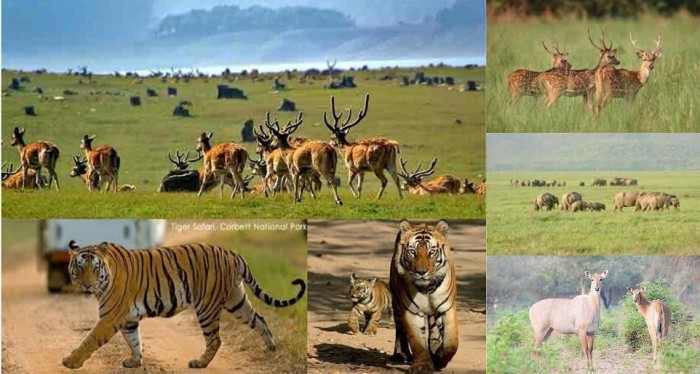About Jim Corbett National Park
Established in 1936, Jim Corbett National Park is the oldest national park in India. The Corbett landscape is very rich in tiger population and this park is a part of the Corbett Tiger reserve that was established to protect the endangered Bengal Tigers. This place was also the first to begin with “Project Tiger”, a project to protect Indian tigers when they were on the brink of extinction in the year 1973. The park which expands over an area of 520 square kilometers is situated in the Nainital district of Uttarakhand, a sub-Himalayan area comprised of hills, grasslands and water bodies and an elevation ranging between 1000 and 4000 feet.
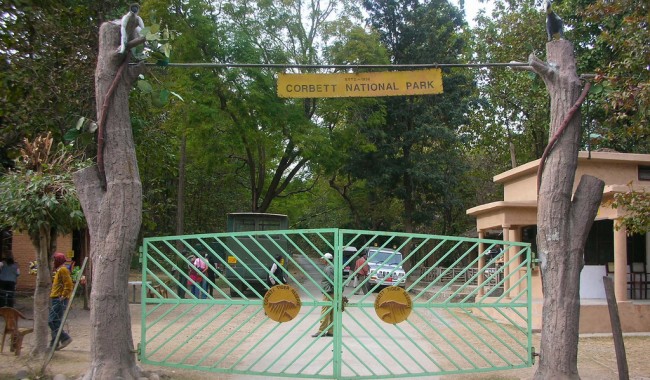
Rivers At Corbett And The Exciting Flora And Fauna
The place possesses the geographical characters and ecosystem native to the sub-Himalayan belt. It houses around five hundred species of flora and a diverse range of fauna making it a good ecotourism area. While the tourism has been good, the increased interference from man serves as one of the major threats to the parks ecological balance. Sal, Khair and Sissoo are the most common types of trees found in the area. Coniferous trees like Chir pine, Banj Oak are found in various parts. Palm trees like Date palm, Kanju, Jamun, Aamla trees are found scattered through the lower area of the park and some of the major trees include Bel, Kusum, Mahua and Bakli. The flowering trees in the area offer color to the park with Kachnaar (pink to white flowers), Semal (red), Dhak (called flame of the forest owing to the bright orange colored flowers) etc. many wildflower species herbs and over 70 species of grass are found in Corbett region.
The park possesses riverine belts and has rivers that supply water which is most essential for the survival of the spectacular and diverse flora and fauna of the region. These rivers flowing through the parks are the prime reason for the heightened biodiversity of the park. The western part of the Ramganga River with Sonanadi, Palain and Mandal, its tributaries form a significant source of water resource for the park. Another form of hydrological resource for the Corbett is the River Kosi that flows by the park, a major portion of which is situated on the river’s bank. These rivers also serve as the drinking water provider for the wild animals in the park.
Top 10 Incredible Health Benefits Being An Adventure Freak-Read On
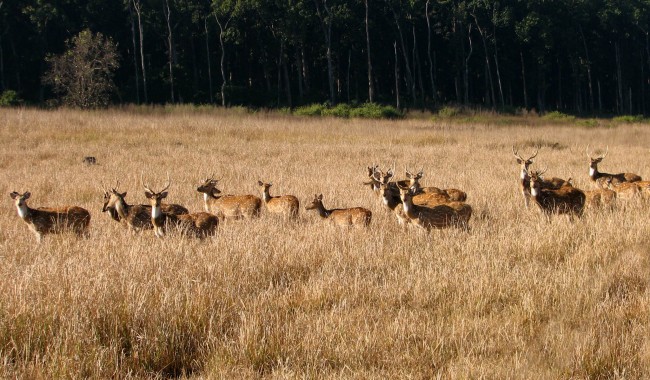
Best Time To Visit
The Jim Corbett National Park timings depend on the five distinct zones as each zone has varying topographies and different visiting periods. But the park itself can be visited all through the year from different zones. Being a prime tourists’ area, the park attracts tourists all through the year who throng the area fascinated by the exotic flora and fauna, natural surroundings and wildlife enormity. The five distinct zones of the park include Jhirna zone, Dhikala zone, Bijrani zone, Sonanandi zone, and Durga Devi zone. The Jhirna is located 16 kilometers from Ramnagar and is accessible throughout the year. The area with its dry topographical features offers round the year visiting opportunities. Other than Jhirna, the Sonanandi zone can be also be visited anytime of the year. The Sonanandi wildlife sanctuary is situated behind the Corbett National Park. The Dhikala zone, which is the core area of the park, is accessible only between 15th of November and 15th of June. The zone considered the most sought area remains closed for the rest of the period. The Durga Devi zone has the same visiting period and is the zone that is situated the farthest from Ramnagar. The Bijrani zone is operational from 1st of October to 30th of June. The reason behind the restricted accessibility of these zones are due to the roads being washed away during monsoon after which the repair works take till the months of October and November to get finished for the roads to become motorable again.
Considering these, the best time to visit the Jim Corbett National park would be from 15th November to 15th June when all the zones remain in operation and the visitors have the opportunity to view the park entirely. The winters also make for easy spotting of animals including the famed Tigers while summers are hot and humid with very temperatures and monsoon heavy with road obstructions.
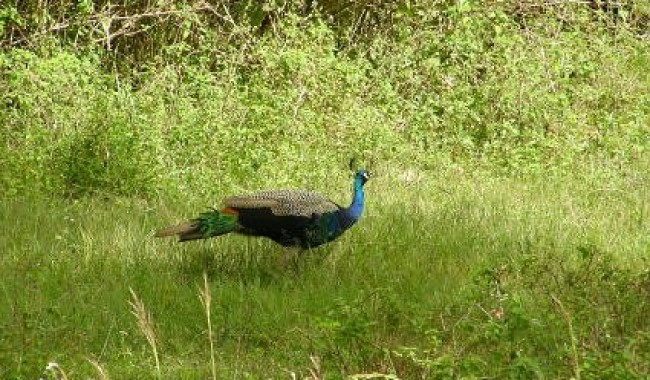
Forest Lodges
Dhikala
Forest lodges or rest houses are available in each of the five tourism zones of the Jim Corbett National Park each with a separate entry gate to provide good access to the visitors. The Dhikala zone which is the core and most well known is situated at the edge of the broad patli Dun Valley which the River Ramganaga flow through in various channels. With the Kanda ridge in the periphery view, Dhikala offers a breathtaking view of the park especially from the Dhikala watchtower. The forest lodge in Dhikala overlooks the Dhikala chaur and Phulai chaur. One of the largest remaining grasslands of the park, these trails offer opportunities of driving through them and opportunity for wildlife sightings including wild elephants, hog deer, raptors and a number of variety of birds. Almost more than a century old, the rest house in Dhikala is a historic old building.
The Sarapduli rest house in the Dhikala – Dhangari road is situated in the southern bank of River Ramganga downstream of Gairal. Sarapduli is famous for its tiger and wild elephant spotting.
The drive from Dhangari to Dhikala leads to the rest house Sultan located in one of the best stretches of the park typifying the dense forest area and named after Sultan Sot, a stream running through the area seasonally.
The Gairal rest house reached by taking a short detour off the main forest road of Dhikala – Dhangari and lies at a place in the banks of the Ramganga river where it first enters the Corbett. The crystal – clear, fast flowing river in this area exhibits a vast difference in character than is found in the downstream areas of Dhikala and flows through Scenic forests. The seclusion of Gairal makes it an ideal spot for tranquil viewing of birds and spotting of wildlife.
The Khinnanauli chaur (trail) is a prime tiger territory and houses the Khinnanauli rest house in its center. Providing an easy getaway into the park’s various parts, this rest house is one which was more recently built.
Situated in the northern parts of the park flanking the mighty Himalayan Mountains is the Kanda. At an elevation of 1100 meters, it is the highest rest house in the region owing to which it offers a panoramic bird’s eye view of the park in its entirety including the Ramganga valley situated down below. The proximity to the Himalayas makes the vegetation in the Kanda region more Himalayan rather than the Shiwalik type found elsewhere in the park. The flora and fauna are Himalayan too and one can spot goral, leopards and Himalayan black bear.
Bijrani
There are two rest houses in the region Malani and Bijrani. 12 kilometers towards the northwest region of Bijrani lies the Malani rest house in the park’s core zones offering visitors a peaceful solitary experience amidst surroundings that are picturesque. Mammals and birds can be spotted in the area. The Bijrani rest house is in an area that once formed a part of shooting block. The Shikaris in the area had Bijrani in high fame due to the game hunting quality offered by the place during the British rule in India. The Bijrani terrain possesses heavier vegetation in comparison with the Dhikala terrain and is drier.
Jhirna
Lying just inside the southern boundary of the park is the Jhirna rest house on the road from Ramnagar to Kalagarh beginning from the east and running to the west of the park. Similar to Bijrani, this area is a lot drier in comparison to Dhikala and heavy on vegetation. Jhirna which until 1994 was a farming village before it was relocated successfully under the “Project Tiger” initiative. Farmland that was consequently abandoned is growing back to its former glory and is being developed into grassland habitats. Tiger, leopard, deer etc. are the most prominent wildlife in the region in addition to special mammals like wild boar and sloth bear.
Sonanandi Wildlife Sanctuary
Apart from these, the Sonanandi wildlife sanctuary also has rest houses. The Lohachaur rest house located in the northern part of the Corbett Tiger Reserve and can be accessed from the Durga Devi zone and entry gate. The forest road connecting the Durga Devi and Vatanvasa traversing from east to west houses the Rathuadhab in the northern buffer a favored spot for elephant spotting. The Halduparao rest house which was built around a century back is situated in the region between Palain and Sonanandi river, just a short distance before the Sonanandi merges into the Ramganga.
The Corbett National Park requires that any visitor seeking accommodation in one of these places especially the Dhikala rest house applies at least two months before the intended period of visit since the rest houses have limited number of rooms and are high on demand and issued on first come first serve basis only.
Night Stay at the Park
The Jim Corbett safari National Park with its entire periphery is a highly restricted and protected area owing to the diversity of wildlife and vegetation in the region. Visits to the region require two kinds of government issued official permits that are required for entry into the park’s different safari zones and to visit the tiger territory which is the core of the park. All visitors including Indian nationals are required to obtain permits to enter the Corbett National park’s tourism zone for day visits. The Government forest lodges also provide night stay options and again this requires obtaining night stay permit. A maximum of three nights of booking is allowed for one visitor and minimum is one night.
Corbett Jeep Safari Information
Jeep Safari in Corbett National Park helps in exploring the exquisite landscape, affluent flora and fauna of the region. Wildlife photographers, nature lovers and adventure seekers will have the best time of their lives during these Safaris. The jeep safari takes visitors deep inside the forests into the barren lands that are still untouched by mankind offering a serene atmosphere far away from the hustle and bustle of the city life. The Jim Corbett National Park has four safari zones Dhikala, Jhirna, Bijrani and Durga Devi and regular safari tours are conducted in each of these zones both in the mornings and the evenings with nearly thirty jeeps entering the park at a time.
The Jhirna zone which is operational all through the years is situated in the southern part of Corbett Park and has safari hours of 6.00 A.M to 9.30 A.M in the mornings and evening hours of 2.30 P.M to 5.30 P.M. A ten day prior advance booking is required for visitors willing to take the early morning safari while evening hours have no such conditions and are allocated on the basis of availability to those who come first. While the seasonal rates vary, the normal rates are stable which include charges for obtaining permits, guide fees, road charges, and jeep charges. The Jeep Safari permits six people at a time and requires identity proof for prior booking.
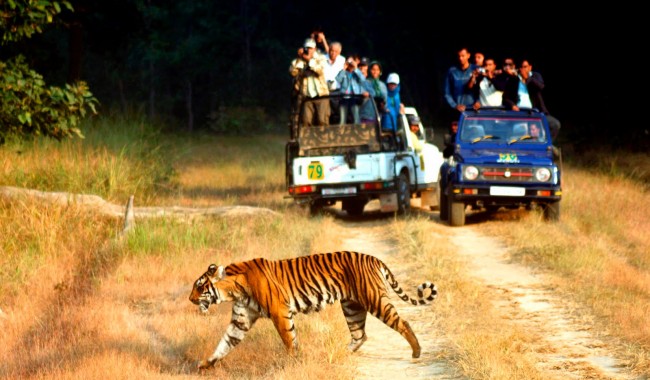
Safari from the Bijrani zone begins through the Aamdanda entry gate just two kilometers away from the Ramganga city. This zone has limited accessibility but the charges, timing and permits are all same as that in the Jhirna zone. Jeep safari helps cover a large area in a short time while also enjoying the nature. Photo Id of the person, proof of Indian nationality and in case of foreigners, passport details are required along with your itinerary to book jeep safari in Corbett National Park. jeep safari in Jim Corbett safari booking can be done in their website by filling out a form along with ID proof. Once booked, the Jeep picks you up from your place of stay and drops you back. The safari charges are non-refundable and all booking procedures are handled by officials of the government based upon Indian Forest Department’s prescribed guidelines.
Corbett Canter Safari
Compared to the jeep safari Canter safari has more members and is cheaper way of going around the park. Canter rides are available in the Dhikala zone of the park. Canter Safaris are also offered twice per day and can carry up to eighteen passengers at a time with the beginning being Ramganga or the Dhangari door. The safari tour lasts five hours through the Dhikala zone and is accompanied by backwood shooter and Corbett tiger hold guide. Similar to jeep safaris these canter safaris are require careful planning and pre booking and follows through almost similar procedures. 6.00 A.M to 12.00 P.M is the first canter safari time and the next is from 11.00 A.M to 5.00 P.M per day.
Corbett Elephant Safari
Elephant Safari in Corbett is available for visitors who are enthusiastic about traversing the park grounds on elephant back, one of the best ways to explore the jungles. The periphery zones in the Jim Corbett National Park and Corbett Tiger Reserve offer elephant back safaris that encompass passing through the thick mysterious forests, beautiful deep valleys and mountains together with the elephant’s rhythmic footsteps and the serenity of the forests. Elephant safaris are also conducted twice per day, first from 6.00 A.M to 8.00 A.M at dawn and towards dusk 4.00 P.M to 6.00 P.M in the evening. For safety purposes, safaris are not encouraged after sunset. But it is possible for tourists to stay overnight at the park and continue their journey to the next day depending on the prior permits obtained for the visit. Different elephant safari itineraries either for a day or for multiple days are available for visitors with different interests.
Entry Gates in Jim Corbett
The core of the park, the Dhikala zone is accessible through the Dhikala gate and is reached via Ramganga. The main entrance for the Dhikala forest lodges is the Dhangari gate which is situated at a distance of 19 Kms from Ramganga and 32 Kms away from Dhikala tourist complex. Since the Dhikala zone is only operational from 15th November to 15th June every year and inaccessible during the monsoon periods, the entry gate is open only during that period. The Dhikala zone also offers canter safari opportunities.
The Jhirna zone is operational throughout the year and Jhirna gate is accessible throughout the year. Only twenty five vehicles, a maximum of thirty is allowed through the gates each day once in the morning and once in the evening. Prior issued permit from Corbett Tiger Reserve is mandatory and all vehicles are required to have a guide for sure.

The Durga Devi gate situated at a distance of 28 Kilometers from Ramganga is the farthest and falls on the Himalayan region and is hence hilly. The park from this entry gate and zone is accessible only from the first of October to the thirtieth of June every year during which the gates remain open.
The Bijrani gate which accessible from Aamdanda and is only a kilometer away from Ramganga is the most obvious choice for visitors who want to access the park during the day and expect easy access. This gate is operational every year during the months of November (15th of November) through June (30th of June) similar to the Dhikala gate. Sixty vehicles per day, that is 30 vehicles in the morning and thirty vehicles in the evening are allowed inside the Bijrani zone every day.
The Sitabani gate which doesn’t come under the Corbett Tiger Reserve has no limitations as to vehicle numbers and makes for an exciting bird watching venue. Similar to Jhirna, this gate is operational round the year but prior permit has to be obtained from the Sitbani forest department and not the Corbett national park.

Pic From : http://tinyurl.com/pa4xspl
Except the Sitabani gate and the Jhirna gate, all other entrance gates are closed during the monsoon season due to broken roads owing to heavy rainfall and time reserved for the officials to repair the road for motor use again. The period between June – October / November, the other zones remain closed.
How To Reach Jim Corbett National Park
The Jim Corbett National Park is well connected to the major cities in and around the region owing to its popularity as a prime ecotourism region and wildlife sanctuary. The nearest airport is the Indira Gandhi International Airport in New Delhi which is located at a distance of 250 Kilometers from Ramnagar which is the Corbett National park’s headquarters and entrance point. While Pantnagar, a domestic airport has been established in the region at a distance of 65 kilometers from the park, there are no regular flights to this airport. The park is easily accessible from the national capital by road or by train.
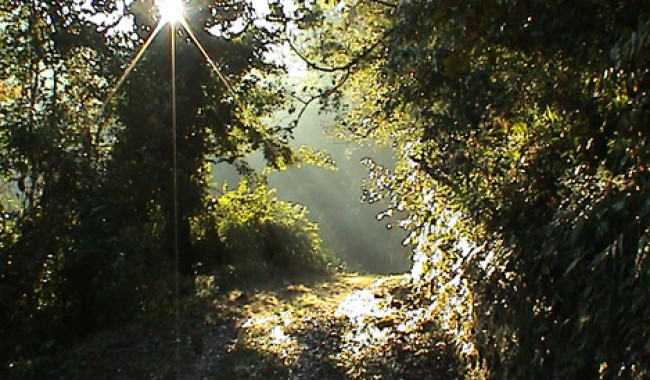
Ramnagar is situated at a distance of 240 Kms from Delhi by road via the Hapur, Gajrola, Moradabad, Kashipur to Ramnagar route.
Gurgaon – Ramnagar measures a distance of 267 Kms including the distance between Gurgaon and Delhi after which the route remains the same.
Ramnagar is situated at a distance of 405 Kms from Lucknow and follows the route Lucknow – Sitapur – Shahjahanpur – Rudrapur – Haldwani and finally Ramnagar.
From Kanpur, Ramnagar is situated at a distance of over 450 kilometers and follows the route of Kanpur – Safipur – Sandi – Shahabad till Shahjahanpur and follows the sililar route from Lucknow.
Jim Corbett National Park is situated at a distance of around 150 kilometers from Nainital and takes approximately three and a half hours to reach. A four hour drive from Dehradun covering a distance of 170 kilometers takes one to the park. Trains from main parts of India are connected to this place via the Ramnagar railway station situated in Uttarakhand.
